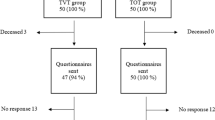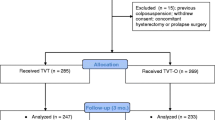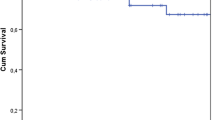Abstract
Purpose
Midurethral slings are a well-established treatment option in women suffering stress urinary incontinence. Various different products and methods are used, therefore, the aim of our study was to compare two inside-out retropubic slings (TVT exact® vs. RetroArc®) inserted in two different ways regarding perioperative and mid-term outcomes.
Methods
In this prospective randomized controlled non-inferiority multicentre trial, primary endpoint was postoperative cure rate, both objective (negative cough test) and subjective (absence of leakage during physical activity using the UDI-6 questionnaire). Secondary endpoints were patients’ satisfaction (Likert scale; ICIQ-UI-SF questionnaires). In addition, intra-and postoperative complications were evaluated. The TVT®-group was operated with an empty bladder, a 18 CH catheter was used with a straight inserter as instructed. Patients randomized into the RetroArc®-group were operated without inserter leading to a reduced catheter size (14 CH), bladder was filled (200 ml) during the procedure.
Results
Of the 303 women, 152 were randomized to the TVT® and 151 to the RetroArc® operation. At 3 months, n = 288 (95.0%) and at 12 months n = 229 (75.6%) were assessed. In postoperative objective cure the RetroArc®-procedure was not inferior to TVT® (p = 0.144). In subjective cure, however, the TVT exact® procedure achieved significant better results (TVT® 76.1%, RetroArc® 54.3%, p = 0.002). Perioperative complications were in majority voiding difficulties and lower after the TVT exact®-procedure.
Conclusions
Retropubic sling procedures are safe and successful to treat female stress urinary incontinence. However, different materials and techniques result in differences between outcomes also experienced surgeons should be aware of.
Similar content being viewed by others
References
Ulmsten U, Henriksson L, Johnson P, Varhos G (1996) An ambulatory surgical procedure under local anesthesia for treatment of female urinary incontinence. Int Urogynecol J Pelvic Floor Dysfunct 7(2):81–85 (discussion 85–86)
Nilsson CG, Kuuva N, Falconer C, Rezapour M, Ulmsten U (2001) Long-term results of the tension-free vaginal tape (TVT) procedure for surgical treatment of female stress urinary incontinence. Int Urogynecol J Pelvic Floor Dysfunct 12(Suppl 2):S5–S8
Nilsson CG, Palva K, Aarnio R, Morcos E, Falconer C (2013) Seventeen years' follow-up of the tension-free vaginal tape procedure for female stress urinary incontinence. Int Urogynecol J 24(8):1265–1269. https://doi.org/10.1007/s00192-013-2090-2
Reisenauer C, Muche-Borowski C, Anthuber C, Finas D, Fink T, Gabriel B, Hubner M, Lobodasch K, Naumann G, Peschers U, Petri E, Schwertner-Tiepelmann N, Soeder S, Steigerwald U, Strauss A, Tunn R, Viereck V, Aigmuller T, Kolle D, Kropshofer S, Tamussino K, Kuhn A, Hofner PD, Kirschner-Hermanns R, Oelke M, Schultz-Lampel D, Klingler C, Henscher U, Kowing A, Junginger B (2013) Interdisciplinary S2e guideline for the diagnosis and treatment of stress urinary incontinence in women: short version—AWMF registry no. 015-005, July 2013. Geburtshilfe und Frauenheilkunde 73(9):899–903. 10.1055/s-0033-1350871
National Collaborating Centre for Women's and Children's Health (UK): National Institute for Health and Clinical Excellence (NICE) Clinical guidelines (2013) Urinary Incontinence: The Management of Urinary Incontinence in Women. RCOG PMID 25340217
Ghoniem G, Stanford E, Kenton K, Achtari C, Goldberg R, Mascarenhas T, Parekh M, Tamussino K, Tosson S, Lose G, Petri E (2008) Evaluation and outcome measures in the treatment of female urinary stress incontinence: International Urogynecological Association (IUGA) guidelines for research and clinical practice. Int Urogynecol J Pelvic Floor Dysfunct 19(1):5–33. https://doi.org/10.1007/s00192-007-0495-5
Bump RC, Mattiasson A, Bo K, Brubaker LP, DeLancey JO, Klarskov P, Shull BL, Smith AR (1996) The standardization of terminology of female pelvic organ prolapse and pelvic floor dysfunction. Am J Obstet Gynecol 175(1):10–17
Uebersax JS, Wyman JF, Shumaker SA, McClish DK, Fantl JA (1995) Short forms to assess life quality and symptom distress for urinary incontinence in women: the Incontinence Impact Questionnaire and the Urogenital Distress Inventory. Continence Program for Women Research Group. Neurourol Urodyn 14(2):131–139
Avery K, Donovan J, Peters TJ, Shaw C, Gotoh M, Abrams P (2004) ICIQ: a brief and robust measure for evaluating the symptoms and impact of urinary incontinence. Neurourol Urodyn 23(4):322–330. https://doi.org/10.1002/nau.20041
Wolfle D, Likert R et al (1949) Standards for appraising psychological research. Am Psychol 4(8):320–328
Boutron I, Altman DG, Moher D, Schulz KF, Ravaud P, Group CN (2017) CONSORT statement for randomized trials of nonpharmacologic treatments: a 2017 update and a consort extension for nonpharmacologic trial abstracts. Ann Intern Med 167(1):40–47. https://doi.org/10.7326/M17-0046
Schulz KF, Altman DG, Moher D, Group C (2010) CONSORT 2010 statement: updated guidelines for reporting parallel group randomized trials. Obstet Gynecol 115(5):1063–1070. https://doi.org/10.1097/AOG.0b013e3181d9d421
Lucas MG, Bosch RJ, Burkhard FC, Cruz F, Madden TB, Nambiar AK, Neisius A, de Ridder DJ, Tubaro A, Turner WH, Pickard RS, Association European, of U, (2012) EAU guidelines on surgical treatment of urinary incontinence. Eur Urol 62(6):1118–1129. https://doi.org/10.1016/j.eururo.2012.09.023
Mock S, Angelle J, Reynolds WS, Osborn DJ, Dmochowski RR, Gomelsky A (2015) Contemporary comparison between retropubic midurethral sling and autologous pubovaginal sling for stress urinary incontinence after the FDA advisory notification. Urology 85(2):321–325. https://doi.org/10.1016/j.urology.2014.10.017
Mucowski SJ, Jurnalov C, Phelps JY (2010) Use of vaginal mesh in the face of recent FDA warnings and litigation. Am J Obstet Gynecol 203(2):103.e101–103.e104. https://doi.org/10.1016/j.ajog.2010.01.060
Reynolds WS, Gold KP, Ni S, Kaufman MR, Dmochowski RR, Penson DF (2013) Immediate effects of the initial FDA notification on the use of surgical mesh for pelvic organ prolapse surgery in medicare beneficiaries. Neurourol Urodyn 32(4):330–335. https://doi.org/10.1002/nau.22318
Kuuva N, Nilsson CG (2002) A nationwide analysis of complications associated with the tension-free vaginal tape (TVT) procedure. Acta Obstet Gynecol Scand 81(1):72–77
McLennan MT, Barr SA, Melick CF, Gavard JA (2012) Bladder perforation during tension-free vaginal tape procedures: abdominal versus vaginal approach. Female Pelvic Med Reconstr Surg 18(1):25–29. https://doi.org/10.1097/SPV.0b013e318240d3f6(discussion 29–31)
Tamussino KF, Hanzal E, Kolle D, Ralph G, Riss PA, Austrian Urogynecology Working G (2001) Tension-free vaginal tape operation: results of the Austrian registry. Obstet Gynecol 98(5 Pt 1):732–736
Tseng LH, Wang AC, Lin YH, Li SJ, Ko YJ (2005) Randomized comparison of the suprapubic arc sling procedure vs tension-free vaginal taping for stress incontinent women. Int Urogynecol J Pelvic Floor Dysfunct 16(3):230–235. https://doi.org/10.1007/s00192-004-1248-3
Novara G, Artibani W, Barber MD, Chapple CR, Costantini E, Ficarra V, Hilton P, Nilsson CG, Waltregny D (2010) Updated systematic review and meta-analysis of the comparative data on colposuspensions, pubovaginal slings, and midurethral tapes in the surgical treatment of female stress urinary incontinence. Eur Urol 58(2):218–238. https://doi.org/10.1016/j.eururo.2010.04.022
Groutz A, Gordon D, Wolman I, Jaffa AJ, David MP, Lessing JB (2002) Tension-free vaginal tape for stress urinary incontinence: Is there a learning curve? Neurourol Urodyn 21(5):470–472. https://doi.org/10.1002/nau.10056
Lebret T, Lugagne PM, Herve JM, Barre P, Orsoni JL, Yonneau L, Saporta F, Botto H (2001) Evaluation of tension-free vaginal tape procedure. Its safety and efficacy in the treatment of female stress urinary incontinence during the learning phase. Eur Urol 40(5):543–547
Kang J, Gou X, Zhao QH, He WY, Xiao MZ, Wang M, Deng YZ (2013) Cough test during tension-free vaginal tape procedure in preventing postoperative urinary retention. Adv Urol 2013:797854. https://doi.org/10.1155/2013/797854
Glavind K, Glavind E (2007) Treatment of prolonged voiding dysfunction after tension-free vaginal tape procedure. Acta Obstet Gynecol Scand 86(3):357–360. https://doi.org/10.1080/00016340601124227
Klutke C, Siegel S, Carlin B, Paszkiewicz E, Kirkemo A, Klutke J (2001) Urinary retention after tension-free vaginal tape procedure: incidence and treatment. Urology 58(5):697–701
Rardin CR, Rosenblatt PL, Kohli N, Miklos JR, Heit M, Lucente VR (2002) Release of tension-free vaginal tape for the treatment of refractory postoperative voiding dysfunction. Obstet Gynecol 100(5 Pt 1):898–902
Song PH, Kim YD, Kim HT, Lim HS, Hyun CH, Seo JH, Yoo ES, Park CH, Jung HC, Gomelsky A (2009) The 7-year outcome of the tension-free vaginal tape procedure for treating female stress urinary incontinence. BJU Int 104(8):1113–1117. https://doi.org/10.1111/j.1464-410X.2009.08504.x
Elzevier HW, Putter H, Delaere KP, Venema PL, Lycklama a Nijeholt AA, Pelger RC (2008) Female sexual function after surgery for stress urinary incontinence: transobturator suburethral tape vs. tension-free vaginal tape obturator. J Sex Med 5(2):400-406. https://doi.org/10.1111/j.1743-6109.2007.00671.x
Caruso S, Rugolo S, Bandiera S, Mirabella D, Cavallaro A, Cianci A (2007) Clitoral blood flow changes after surgery for stress urinary incontinence: pilot study on TVT Versus TOT procedures. Urology 70(3):554–557. https://doi.org/10.1016/j.urology.2007.04.045
Matarazzo MG, Cianci S, Rampello L, Presti LL, Caruso S (2013) Urethral sphincter innervation and clitoral blood flow after the transobturator (TOT) approach. Int Urogynecol J 24(4):621–625. https://doi.org/10.1007/s00192-012-1891-z
Acknowledgements
The authors acknowledge the initial support by a clinical trial grant from AMS. In addition, all contribution in recruitment is acknowledged.
Funding
Initially supported by a clinical trial grant from AMS. After having stopped producing mesh products the study continued without funding. AMS was not involved in study setup, design, data acquisition, data analysis, data interpretation or editing of this study.
Author information
Authors and Affiliations
Contributions
JM: Protocol/project development, data collection or management, data analysis, and manuscript writing/editing. CR: Protocol/project development, data collection or management, and manuscript writing/editing. TSM: Protocol/project development, data collection or management, and manuscript writing/editing. FS: Data collection or management, data analysis, and manuscript editing. RT: Protocol/project development, data collection or management, data analysis, and manuscript writing/editing. MH: Protocol/project development, data collection or management, data analysis, and manuscript writing/editing.
Corresponding author
Ethics declarations
Conflict of interest
Juliane Marschke: (speaker honorar) AMS, Astellas. Christl Reisenauer: (speaker honorar) Astellas, AMS, Allergan, Medtronic, Coloplast. Tomi S Mikkola: Unrestricted grant from Contura, speaker for Astellas and Mylan. Ralf Tunn: (speaker honorar) AMS, Astellas, Allergan, Promedon. Markus Huebner: None.
Ethical approval
All procedures performed in studies involving human participants were in accordance with the ethical standards of the institutional and/or national research committee and with the 1964 Helsinki Declaration and its later amendments or comparable ethical standards.
Informed consent
Informed consent was obtained from all individual participants included in the study.
Additional information
Publisher's Note
Springer Nature remains neutral with regard to jurisdictional claims in published maps and institutional affiliations.
Rights and permissions
About this article
Cite this article
Marschke, J., Reisenauer, C., Mikkola, T.S. et al. Comparison of two retropubic tension-free vaginal tape procedures in women with stress urinary incontinence: a randomized controlled multicenter trial. Arch Gynecol Obstet 299, 1015–1022 (2019). https://doi.org/10.1007/s00404-019-05077-0
Received:
Accepted:
Published:
Issue Date:
DOI: https://doi.org/10.1007/s00404-019-05077-0




